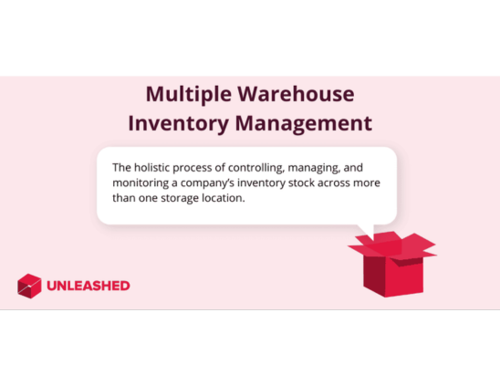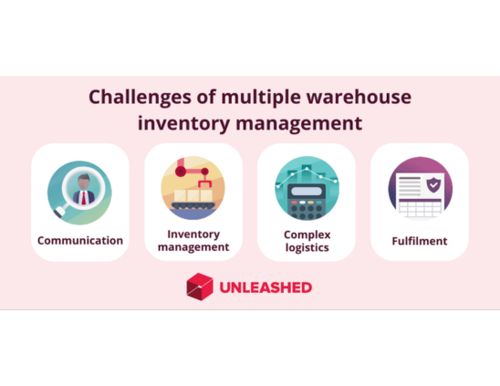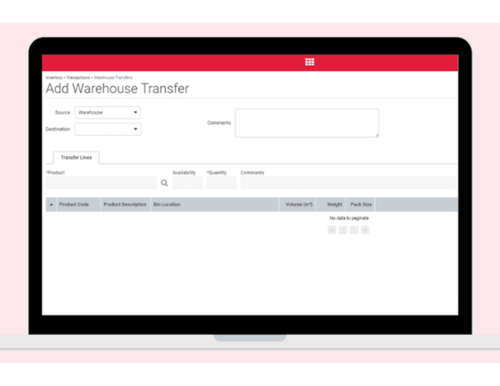
What is multiple warehouse inventory management?
Multiple warehouse inventory management refers to the dynamic monitoring and controlling of goods at different storage locations. A multi-warehouse inventory management strategy considers all aspects of running an efficient warehouse – including receiving, storage, order fulfilment, and accounting – and coordinates those tasks between premises.
The goal of multiple warehouse inventory management is to optimise stock accuracy and improve business efficiency. It helps you reduce inventory carrying costs and customer delivery times while maintaining an accessible flow of sales, purchasing, and inventory data between each location.

Why is multiple warehouse inventory management important?
Multiple warehouse inventory management enables companies to work as a single team and improve operational efficiency across different warehouses.
The primary benefit of storing goods in multiple geographical locations is that it makes it easier to cater to unique markets without adding extra burden to inventory managers.
It also makes it possible to separate goods by storage needs. For example, you might have one warehouse that’s designed to store items at a specific temperature while a separate warehouse manages stock that can be stored at room temperature.
A multiple warehouse management strategy ensures items are shipped to customers from the nearest location to improve delivery times and costs, and ensures key information is accurately communicated between each warehouse.
Benefits of a multiple warehouse inventory management strategy
Adopting a central multiple warehouse inventory management strategy solves many of the challenges that come with expanding to more storage locations. It creates a seamless way of working that can be adopted across the business and tweaked to suit any unique requirements.
The main benefits of an optimised multi-warehouse inventory strategy include:
- Multiple warehouse inventory visibility
- Improved forecasting and resource planning
- Reduced time and cost for deliveries
- Reduced picking and receiving errors
- Improved business agility
- Fewer business risks
- An enhanced purchasing process
If you’re looking to expand into new storage locations, multiple warehouse inventory management is the key to pulling it off with minimal risk and fewer costs or mistakes.
The challenges of managing inventory in multiple warehouses
The risks associated with inventory management increase with each new inventory location. Inventory shrinkage, overstocking, or understocking in one warehouse creates ripples that negatively impact the performance of other locations.
Here are four of the biggest multiple warehouse inventory management challenges.

1. Communication between warehouse locations
Unless there are policies, processes, and systems in place to facilitate better collaboration, poor communication between teams can hurt productivity and business performance.
For example, if an item is out of stock in one warehouse but available in another, a customer ordering that item may have to wait longer than necessary to receive their goods. But if a strong line of communication exists, the item could be shipped sooner from the warehouse that still has availability.
2. Inefficient inventory management processes
Good inventory management relies on streamlined workflows, accurate data, and clear channels of communication. If you aren’t actively working together across locations with an overarching strategy to guide decisions, teams may act independently of one another – to the detriment of others.
Common inventory management issues when managing multiple warehouses include:
- Running out of stock or overstocking because demand forecasting is not performed holistically.
- Maintaining inaccurate inventory records because stock levels are not synced between locations.
- Inconsistent replenishment processes that don’t consider the purchasing needs of each warehouse.
A cloud-based inventory management system is the foundation of an effective multiple inventory management strategy. The software can help you optimise stock levels, share data, and improve collaboration across unlimited inventory locations.
Note: Unlike other providers, Unleashed inventory management software offers multiple warehouse inventory tracking functionality with every plan at no extra cost. To discover how Unleashed helps you reduce costs and maximise efficiency across multiple warehouses, start a risk-free 14-day trial of Unleashed today.
3. Complex logistics processes
Adding extra storage locations to your business can increase the complexity of warehouse logistics. It becomes more challenging to ensure each stock item is in the right place, at the right time, and in the optimal quantities.
Without insights to see what’s going on and no centralised strategy to guide decision-makers, you can’t streamline or optimise routes. You’ll also lack the visibility that informs when or where to ship goods, and it’s harder to provide accurate shipping rates and lead times to customers.
4. Order fulfilment errors
There is a higher risk of errors occurring when fulfilling customer orders if your workflows are not synchronised between each warehouse. It’s also difficult to coordinate orders across locations without the seamless sharing of data, as everything must be done manually.
Managing multiple warehouses without a collaborative strategy puts your business at risk of low customer satisfaction rates resulting from frequent picking errors.
How to manage inventory in multiple warehouses
Effectively managing inventory across warehouses requires the careful implementation of a multi-warehouse strategy, new technology investments, and accurate demand forecasting.
When combined, this recipe will enable you to track everything coming and going – no matter the location – and make it easier to plan for future requirements.
Follow these steps to effectively manage inventory in multiple warehouses:
- Implement warehouse inventory management software
- Centralise important data between warehouses
- Integrate warehouse management technology to improve efficiency
- Standardise processes across each warehouse location
- Optimise warehouse layouts to improve transport and fulfilment times
- Identify and monitor supplier lead times for each warehouse
- Adapt your returns policies to multiple warehouses
- Improve internal logistics processes between warehouses
1. Implement warehouse inventory management software
Cloud-based warehouse inventory management software offers real-time tracking of stock levels and improves the efficiency of your inventory control processes. It can also provide automated solutions for managing production, supply chain, sales, and purchasing.
Modern systems, like Unleashed, enable multiple warehouse inventory management by allowing you to assign unique inventory locations (warehouses) and quantities to each of your stocked items.

2. Centralise important data between warehouses
Collaboration is key to an effective multiple warehouse inventory strategy. For warehouse teams across locations to better communicate, and for head office teams to do their jobs more effectively, everyone needs access to a central database that contains all the organisation’s data.
Depending on the size and complexity of your business, this can be done using inventory management software, an ERP inventory management system, or a warehouse management system.
However, you should also continue to track individual locations separately.
No two inventory locations will be the same. Each warehouse will have different costs, supplier lead times, and fulfilment efficiencies based on how they operate.
Tracking the performance of your business holistically will provide an accurate picture of how well your company is doing; while tracking the individual performance of each warehouse will help you better allocate resources, optimise processes, and make smarter purchasing decisions.
3. Integrate warehouse management technology to improve efficiency
In addition to software tools, there are various warehouse management solutions you can invest in to improve efficiency in your warehouse processes.
This technology will help you shorten fulfilment times, improve picking and inventory accuracy, and establish optimised workflows for each stage in the product life cycle.
Here are some examples of useful multiple warehouse management tools:
- Barcode scanners
- Mobile receiving carts
- Andon signals
- Voice-picking systems
- Docks
- Pallet trucks
- Forklifts
- Warehouse robotics
- Automated storage and retrieval systems
- Automatic guided vehicles
- Sortation systems
Learn more: Warehouse Order Picking Methods: A Complete Guide
4. Standardise processes across each warehouse location
Organisational warehouse processes should be standardised across the business to ensure consistency and data accuracy.
While each location may have slightly different needs, requiring a tweaking of some of these processes, a standard approach enables teams to ‘speak the same language’ – improving collaboration between locations.
Communication policies should also be audited – and, if required, rewritten – to standardise and encourage better communication between key stakeholders on any given task.
5. Optimise warehouse layouts to improve transport and fulfilment times
The layout of your warehouses directly affects how efficiently you can manage inventory and fulfil customer orders. Optimising warehouse layouts will help you shorten the time it takes to transport inventory from one area to another, retrieve goods for order fulfilment, and perform stock takes.
Consider relocating fast-moving items, such as your top-sellers, close to the packing area. These should also be stored close to eye level to minimise time spent bending down or climbing ladders to retrieve goods.
6. Identify and monitor supplier lead times for each warehouse
Supplier lead time is the number of minutes, days, or hours it takes to receive ordered goods from the moment you place a purchase order. Based on the geographical location of your warehouses, lead times can vary between each storage facility.
Lead times should be measured on a per-warehouse basis. This will help you adjust your storage strategy and accurately predict fulfilment times.
7. Adapt your returns policies to multiple warehouses
Your company returns policy should be adapted to suit the accessibility of different storage locations for customers and couriers.
If you only allow returns to be sent to one location, but you have other warehouses closer by, you may be missing out on the opportunity to trim costs and improve customer satisfaction compared with allowing customers to return to their nearest location instead.
However, handling returns across multiple locations requires a more centralised, data-driven returns management process.
8. Improve internal logistics processes between warehouses
Improving your ability to send stock between locations or deliver items from more convenient storage locations can help reduce logistics costs while improving delivery speeds.
Optimal route planning involves the careful mapping of driving routes, fuel costs and delivery options, but it’s also more than that.
To further optimise logistics planning, you should:
- Get good at forecasting. Knowing expected customer demand will help you move the right amount of goods to the right location in advance and cut delivery times.
- Maintain optimal inventory levels. Keeping a close eye on inventory levels across locations will allow you to replenish stock from a different warehouse, so your customers aren’t kept waiting after a stockout.
- Improve order distribution. Evenly distributing orders across nearby warehouse locations can ease the burden on any single location, preventing overloading.
- Consider cross-docking. Cross-docking may assist in turning goods around more quickly, trimming holding costs and improving delivery speeds.
Learn more: A Complete Guide to Warehouse Consolidation
Multiple warehouse inventory management software
Multiple warehouse inventory management software is a system that provides centralised visibility and control over day-to-day warehouse and inventory tasks. It can automate your manual processes, – such as stock counting, batch tracking, and data management – to boost warehouse efficiency and inventory accuracy for each warehouse.
Key features of multiple warehouse inventory management software:
- Real-time multiple warehouse inventory tracking
- Barcode scanning integration
- Supplier management
- Purchase order management
- Inventory optimisation and demand forecasting
- Stocktaking software
- Multichannel order management
- Inventory reporting and analytics
To get started with multiple warehouse inventory management software, start a free trial of Unleashed today or book a chat with one of our warehouse management experts to determine the solution that’s right for your business.
